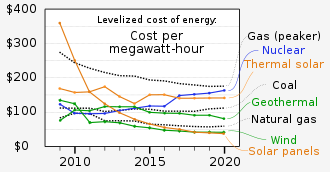Various techniques for electricity age can cause a wide range of expenses, which can be separated into three general classes: 1) discount expenses or all expenses paid by utilities related to gaining and circulating electricity to purchasers, 2) retail costs paid by customers, and 3) outside expenses, or externalities, forced on society. Markdown costs integrate starting capital, exercises, upkeep (O&M), transmission, and costs of decommissioning. Dependent upon the area’s managerial environment, some or all Amigo Energy may be gone through to buyers. These are costs per unit of Amigo Energy, consistently tended to as dollars/megawatt hour (rebate). The assessments furthermore help state-run organizations in seeking decisions concerning energy systems.

Levelized cost of electricity
The levelized cost of electricity (LCOE) is a metric that undertakings to take a gander at the costs of different methods for electricity age reliably. Anyway, LCOE is ordinarily presented as the base consistent expense at which electricity ought to be proposed to make back the underlying speculation over the lifetime of the endeavor, such a cost assessment requires notions about the value of various non-money related costs (normal impacts, close by openness, others), and is thusly problematic. For the not entirely set in stone, LCOE is the net present worth of all costs over the lifetime of the asset isolated by an appropriately restricted outright of the energy yield from the asset over that lifetime.
Levelized cost of capacity
The levelized cost of capacity (LCOS) is undifferentiated from LCOE however applied to energy capacity advancements like batteries. Despite the innovation, be that as it may, capacity is nevertheless an optional wellspring of electricity reliant upon an essential wellspring of age. In this manner, genuine expense bookkeeping requests that the expenses of both essential and optional sources be incorporated when the expense of capacity is contrasted with the expense of creating electricity progressively to satisfy the need.
An expense factor special to stockpiling is misfortunes that happen because of inborn failures of putting away electricity, as well as expanded CO2 outflows if any part of the essential source is under 100 percent without carbon. In the U.S., a thorough 2015 investigation discovered that net framework CO2 outflows coming about because of capacity activity are nontrivial when contrasted with the emanations from electricity age [in continuous to meet demand], going from 104 to 407 kg/MWh of conveyed energy relying upon area, capacity activity mode, and suppositions in regards to carbon power.
Levelized kept away from the cost of electricity
The metric levelized stayed away from the cost of energy (Trim) addresses a portion of the weaknesses of LCOE by considering the monetary worth that the source gives to the lattice. The financial worth considers the dispatchability of an asset, as well as the current energy blend in a locale. In 2014, the US Energy Information Association proposed that levelized costs of non-dispatchable sources like breeze or sun control appeared differently concerning the levelized avoided expense of energy (Lace) rather than the LCOE of dispatchable sources like oil subsidiaries or geothermal. Trim is the avoided costs from various sources isolated by the yearly aftereffect of the non-dispatchable source.
Esteem changed the levelized cost of electricity
The worth changed levelized cost of electricity (VALCOE) is a measurement concocted by the Global Energy Organization which incorporates both the expense of the electricity and the worth of the electricity framework. For example, a comparative proportion of electricity is more significant during a time of zenith interest. In any case, VALCOE doesn’t think about future changes to the electricity system, for example, the extension of significantly more sun-based power could decrease late morning regard anyway the present VALCOE doesn’t think about that.

